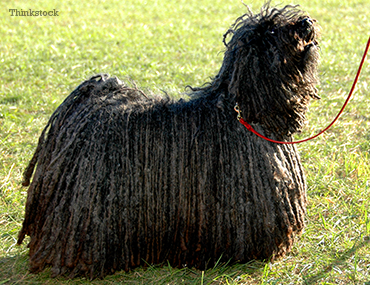Background
The Puli is an ancient sheepdog from Hungary and was brought from Asia by the Magyars over 1,000 years ago. Pulis were used for herding and guarding livestock. They worked together with the huge Komondor: a Hungarian breed of dog. The Komondor guarded sheep and cattle during the night while the Puli herded and guarded them during the day. If wolves or bears ever tried to attack the livestock the Puli would alert the group and summon the Komondors to help fight off the intruders. Because Puli’s thick coats protected their skin from bites the Puli had an edge when fighting off wolves. A Puli might sometimes have been called on to work during the night in place of a Komondor depending on the color of their coat. Light-colored dogs were used at night because they could be easily seen while the dark-colored dogs only managed daytime rituals.
The Puli was recognized by the American Kennel Club in 1936.
Sizing up
- Weight: 25 to 35 lbs.
- Height: 16 to 17 inches
- Coat: Medium to long double coat of thin or thick cords either flat or round. The topcoat is dense and weather-resistant with wavy or curly cords, and the undercoat is soft, wooly and dense.
- Color: Solid and usually black, less common colors are white, gray, or cream
- Life expectancy: 12 to 14 years
What’s the Puli like?
The Puli is fun, energetic, and playful. Bred to be a guard dog for livestock, he is very loyal and protective of his family. He’s highly active and needs a lot of exercise, preferably, outside where he can run. He would love to live in the countryside where he would have room to stretch his legs. If left alone in an enclosed space or indoors for too long he can grow restless.
The Puli is a very intelligent and determined breed; he’ll do well with early obedience training. He can learn quite a bit even at only eight weeks of age. Socialization is a key part of training and it needs to be started early.
When it comes to grooming, you can either brush your Puli’s coat or let it cord; however, if you plan to brush it you should also be prepared to invest a serious amount of time. You’ll need to brush it at least once every two days.
Health
Pulis are generally healthy but you should be aware of the potential for either of the following conditions:
Hip dysplasia occurs when the hip joints don’t develop correctly. It’s often seen in larger dogs but because it’s primarily genetic any sized dog can be affected, including Pulis. It’s possible that rapid growth and a higher energy diet are combining to exacerbate the condition in large dogs. This might mean that although small dogs like the Puli have hip dysplasia many of them show no symptoms. Learn More about hip dysplasia here. > Hip dysplasia
Luxating Patella is primarily hereditary and occurs when a groove in the femur is too shallow, causing the kneecap to slide out of place. It can cause a noticeable limp. Statistically the condition occurs most often in small breeds like the Puli but the genetic reasoning behind this is unclear. What is clear is that skeletal abnormalities are present at birth. Learn more about Luxating Patella here. > Luxating Patella
Takeaway Points
- The Puli sheds very little.
- The Puli would make a great watch dog.
- The Puli is not always suitable for city living.
- The Puli is great with children as long as he’s raised with them.
If you have any questions or concerns, you should always visit or call your veterinarian -- they are your best resource to ensure the health and well-being of your pets.
